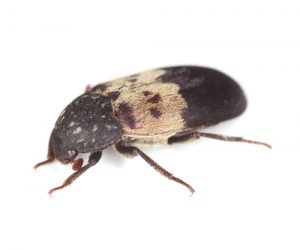Larder Beetles Infest Meats
By Chris Williams on December 2, 2011.
Q. We have a small farm with a little smokehouse out back and we have some hams hanging there. When I went in there yesterday, I saw several insects crawling on the hams. They look like beetles, mostly black with yellow across the center. I tried to look them up on the Internet and the closest I could come was larder beetles. Shouldn’t larder beetles be in a kitchen?
A. “Larder” is an old term that refers an area where meats and other foods are stored. Before refrigeration, foods (including meats) were stored in a separate room called a larder, similar to our pantries. Larders were situated on the shadiest side of the home, but near the kitchen, to keep food cool. They usually had hanging hooks for meat, and meat is what larder beetles like.
Your description does sound like the larder beetle. It’s about 1/3-inch long, and is dark brown to black with a pale yellow six-spotted band on its back. Its abdomen is covered with fine yellow hairs. The larval form is yellowish-brown, hairy and wormlike, with two short, curved spines at its rear end.
 The larder beetle is what we call a “stored product pest” but it’s not as common as flour beetles and some of the other pests that we find in our packaged foods. Instead of feeding on grain products, the larder beetle feeds mainly on meats. For obvious reasons, it was more of a pest 100 years ago, before refrigeration and improved food storage, when meats were hung in store rooms or larders.
The larder beetle is what we call a “stored product pest” but it’s not as common as flour beetles and some of the other pests that we find in our packaged foods. Instead of feeding on grain products, the larder beetle feeds mainly on meats. For obvious reasons, it was more of a pest 100 years ago, before refrigeration and improved food storage, when meats were hung in store rooms or larders.
Larder beetles feed on high protein foods and cured meats like hams, bacon, and cheeses, dried fish, pet food, skins, hides, carcasses, and dead insects. They can be pests in taxidermy shops and in poultry houses where they feed on bird carcasses and chicken feed. Museums sometimes purposely use larder beetle larvae to clean the flesh from bones to be studied or displayed! In homes, larder beetles can be found feeding on carcasses or accumulations of dead flies in attics or voids. Both the adults and the larvae do the feeding, but larvae do most of the damage.
In the case of your hams, here’s what you can expect: Each female larder beetle lays about 100 eggs on the hams. When the eggs hatch, the larvae begin feeding near the surface, gradually working their way under any wrappings on the ham. Once under the wrappings, they are difficult to see as they tunnel into the ham itself. Larvae can be full grown and ready to pupate in about two months (depending on temperature). At that time, they will pupate in the ham or may instead wander away from the food and bore into wood or other materials (even lead!) looking for a place to pupate. When the adult beetles emerge about 3 weeks later, they will return to the hams and lay eggs again. The fact that you have seen several adults probably means that there has already been at least one generation of larvae feeding on your hams.
You’ll have to check the hams but if they are full of larder beetle larvae, you’ll want to discard them. If you’re going to store hams in this same location again, you may want to contact a pest control company first.